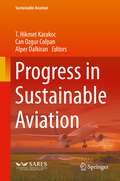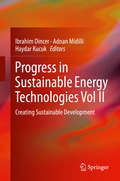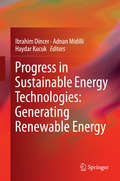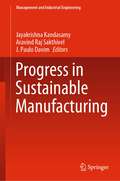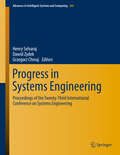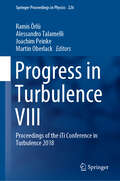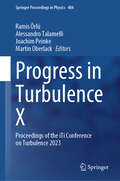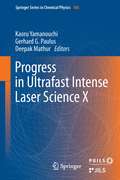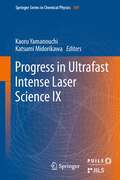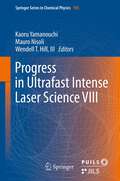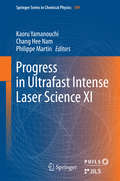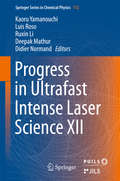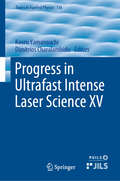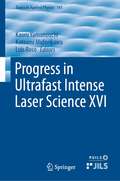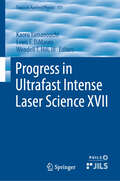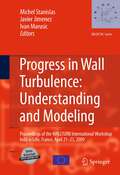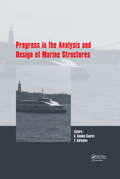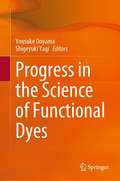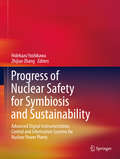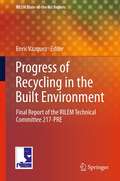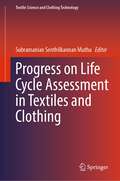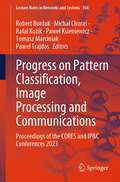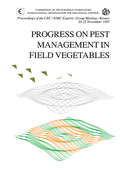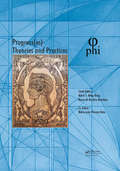- Table View
- List View
Progress in Sustainable Aviation (Sustainable Aviation)
by T. Hikmet Karakoc Can Ozgur Colpan Alper DalkiranProgress in Sustainable Aviation looks at recent progress and new technological developments in sustainable aviation, presenting readers with engineering solutions and methodologies for efficiency and cost savings, performance improvement, and emission reduction. Coverage includes alternative fuel types, propulsion technologies, and emission technologies used in different aerial vehicles, such as unmanned aerial vehicles, drones, and passenger aircraft. Operational areas, such as the building of green airports, commercial air transport, and maintenance management are also addressed. This collection will be a valuable reference for researchers, practicing engineers, scientists, and students working in the area of sustainable aviation technology and management. Looks at recent progress in sustainable aviation technologies;Presents alternative aviation fuel types and propulsion technologies;Includes case studies and practical applications.
Progress in Sustainable Energy Technologies Vol II
by Ibrahim Dincer Adnan Midilli Haydar KucukThis multi-disciplinary volume presents information on the state-of-the-art in the sustainable development technologies and tactics. Its unique amalgamation of the latest technical information, research findings and examples of successfully applied new developments in the area of sustainable development will be of keen interest to engineers, students, practitioners, scientists and researchers concerned with sustainability. Problem statements, projections, new concepts, models, experiments, measurements and simulations from not only engineering and science, but disciplines as diverse as ecology, education, economics and information technology are included, in order to create a truly holistic vision of the sustainable development field. The contributions feature coverage of topics including green buildings, exergy analysis, clean carbon technologies, waste management, energy conservation, environmental remediation, energy security and sustainable development policy.
Progress in Sustainable Energy Technologies: Generating Renewable Energy
by Ibrahim Dincer Adnan Midilli Haydar KucukThis multi-disciplinary volume presents information on the state-of-the-art in sustainable energy technologies key to tackling the world's energy challenges and achieving environmentally benign solutions. Its unique amalgamation of the latest technical information, research findings and examples of successfully applied new developments in the area of sustainable energy will be of keen interest to engineers, students, practitioners, scientists and researchers working with sustainable energy technologies. Problem statements, projections, new concepts, models, experiments, measurements and simulations from not only engineering and science, but disciplines as diverse as ecology, education, economics and information technology are included, in order to create a truly holistic vision of the sustainable energy field. The contributions feature coverage of topics including solar and wind energy, biomass and biofuels, waste-to-energy, renewable fuels, geothermal and hydrogen power, efficiency gains in fossil fuels and energy storage technologies including batteries and fuel cells.
Progress in Sustainable Manufacturing (Management and Industrial Engineering)
by J. Paulo Davim Aravind Raj Sakthivel Jayakrishna KandasamyThis book provides recent developments in sustainable manufacturing ranging from product designing to product delivery. It focuses on key challenges and solutions at various stages such as product design, material selection, material processing, manufacturing and energy consumption to ensure sustainability at every stage of product lifecycle. It further offers solutions to build sustainable product by responsible consumption and production. The role of advanced technologies in sustainable manufacturing is also covered in this book. Given the topics covered, this book will be useful for the researchers and professionals working in the area of mechanical engineering, especially industrial and production engineering.
Progress in Systems Engineering
by Henry Selvaraj Dawid Zydek Grzegorz ChmajThis collection of proceedings from the International Conference on Systems Engineering, Las Vegas, 2014 is orientated toward systems engineering, including topics like aero-space, power systems, industrial automation and robotics, systems theory, control theory, artificial intelligence, signal processing, decision support, pattern recognition and machine learning, information and communication technologies, image processing, and computer vision as well as its applications. The volume's main focus is on models, algorithms, and software tools that facilitate efficient and convenient utilization of modern achievements in systems engineering.
Progress in Turbulence VIII: Proceedings of the iTi Conference in Turbulence 2018 (Springer Proceedings in Physics #226)
by Joachim Peinke Martin Oberlack Alessandro Talamelli Ramis ÖrlüThis volume collects the edited and reviewed contributions presented in the 8th iTi Conference on Turbulence, held in Bertinoro, Italy, in September 2018. In keeping with the spirit of the conference, the book was produced afterwards, so that the authors had the opportunity to incorporate comments and discussions raised during the event. The respective contributions, which address both fundamental and applied aspects of turbulence, have been structured according to the following main topics: I TheoryII Wall-bounded flowsIII Simulations and modellingIV ExperimentsV Miscellaneous topicsVI Wind energy
Progress in Turbulence X: Proceedings of the iTi Conference on Turbulence 2023 (Springer Proceedings in Physics #404)
by Joachim Peinke Martin Oberlack Alessandro Talamelli Ramis ÖrlüThis book collects the edited and reviewed contribution presented in the 10th iTi conference in Bertinoro, covering fundamental and applied aspects in turbulence. In the spirit of the iTi conference, the book is produced after the conference so that the authors had the opportunity to incorporate comments and discussions raised during the meeting. The iTi has become an established biannual conference on turbulence research with 80 to 100 participants and places value on creating an environment to stimulate discussions and personal contacts in the beautiful town of Bertinoro in Northern Italy close to Bologna, continuing a tradition that has started in Bad Zwischenahn/Germany with the first edition of the conference in 2003. The content-related focus areas of the conference are the interdisciplinary aspects of turbulence, defining the abbreviation iTi—interdisciplinary turbulence initiative. iTi attracts scientist from the engineering, physics, and mathematics communities.
Progress in Ultrafast Intense Laser Science
by Kaoru Yamanouchi Gerhard G. Paulus Deepak MathurThe PUILS series delivers up-to-date reviews of progress in Ultrafast Intense Laser Science, a newly emerging interdisciplinary research field spanning atomic and molecular physics, molecular science, and optical science, which has been stimulated by the recent developments in ultrafast laser technologies. Each volume compiles peer-reviewed articles authored by researchers at the forefront of each their own subfields of UILS. Every chapter opens with an overview of the topics to be discussed, so that researchers unfamiliar to the subfield, as well as graduate students, can grasp the importance and attractions of the research topic at hand; these are followed by reports of cutting-edge discoveries. This tenth volume covers a broad range of topics from this interdisciplinary research field, focusing on electron scattering by atoms in intense laser fields, atoms and molecules in ultrashort pulsed EUV and X-ray light fields, filamentation induced by intense laser fields, and physics in super-intense laser fields.
Progress in Ultrafast Intense Laser Science
by Kaoru Yamanouchi Katsumi MidorikawaThe PUILS series delivers up-to-date reviews of progress in Ultrafast Intense Laser Science, a newly emerging interdisciplinary research field spanning atomic and molecular physics, molecular science, and optical science, which has been stimulated by the recent developments in ultrafast laser technologies. Each volume compiles peer-reviewed articles authored by researchers at the forefront of each their own subfields of UILS. Every chapter opens with an overview of the topics to be discussed, so that researchers unfamiliar to the subfield, as well as graduate students, can grasp the importance and attractions of the research topic at hand; these are followed by reports of cutting-edge discoveries. This ninth volume covers a broad range of topics from this interdisciplinary research field, focusing on ultrafast molecular responses to an intense laser field, advanced techniques for attosecond pulse generation, atomic and molecular responses to attosecond pulses, photoelectron spectroscopy of atoms and molecules interacting with intense light fields, and attosecond pulse interaction with solid materials.
Progress in Ultrafast Intense Laser Science VIII
by Kaoru Yamanouchi Mauro Nisoli Wendell T. Hill IIIThe PUILS series delivers up-to-date reviews of progress in Ultrafast Intense Laser Science, a newly emerging interdisciplinary research field spanning atomic and molecular physics, molecular science and optical science which has been stimulated by the recent developments in ultrafast laser technologies. Each volume compiles peer-reviewed articles authored by researchers at the forefront of each their own subfields of UILS. Every chapter opens with an overview of the topics to be discussed, so that researchers unfamiliar to the subfield as well as graduate students can grasp the importance and attractions of the research topic at hand. These are followed by reports of cutting-edge discoveries. This eighth volume covers a broad range of topics from this interdisciplinary research field, focusing on molecules interacting with ultrashort and intense laser fields, advanced technologies for the characterization of ultrashort laser pulses and their applications, laser plasma formation and laser acceleration.
Progress in Ultrafast Intense Laser Science XI
by Philippe Martin Kaoru Yamanouchi Chang Hee NamThe PUILS series delivers up-to-date reviews of progress in Ultrafast Intense Laser Science, a newly emerging interdisciplinary research field spanning atomic and molecular physics, molecular science and optical science, which has been stimulated by the recent developments in ultrafast laser technologies. Each volume compiles peer-reviewed articles authored by researchers at the forefront of each their own subfields of UILS. Every chapter opens with an overview of the topics to be discussed, so that researchers unfamiliar to the subfield, as well as graduate students, can grasp the importance and attractions of the research topic at hand; these are followed by reports of cutting-edge discoveries. This eleventh volume covers a broad range of topics from this interdisciplinary research field, focusing on ultrafast dynamics of molecules in intense laser fields, pulse shaping techniques for controlling molecular processes, high-order harmonics generation and attosecond Photoionization, femtosecond laser induced filamentation and laser particle acceleration.
Progress in Ultrafast Intense Laser Science XII
by Kaoru Yamanouchi Deepak Mathur Didier Normand Luis Roso Ruxin LiThis volume covers a broad range of topics focusing on atoms, molecules, and clusters interacting in intense laser field, laser induced filamentation, and laser plasma interaction and application. The PUILS series delivers up-to-date reviews of progress in Ultrafast Intense Laser Science, a newly emerging interdisciplinary research field spanning atomic and molecular physics, molecular science, and optical science, which has been stimulated by the recent developments in ultrafast laser technologies. Each volume compiles peer-reviewed articles authored by researchers at the forefront of each their own subfields of UILS. Every chapter opens with an overview of the topics to be discussed, so that researchers unfamiliar to the subfield, as well as graduate students, can grasp the importance and attractions of the research topic at h∧ these are followed by reports of cutting-edge discoveries.
Progress in Ultrafast Intense Laser Science XV (Topics in Applied Physics #136)
by Kaoru Yamanouchi Dimitrios CharalambidisThis book covers a diverse cross section of this interdisciplinary research field, with contributions grouped into four categories: laser-induced filamentation; atoms and molecules in a laser field; interaction of solid materials with a coherent light field; and ion acceleration and ionization of atoms in super intense laser fields.This book series presents up-to-date reviews of advances in this interdisciplinary research field, spanning atomic and molecular physics, as well as molecular and optical science, which have been stimulated by the recent developments in ultrafast laser technologies. Each book compiles peer-reviewed articles by researchers at the forefront of their particular subfields. All the chapters include an overview to allow graduate students and researchers unfamiliar with the subfield to grasp the importance and attractions of the topic covered, followed by reports of cutting-edge discoveries.
Progress in Ultrafast Intense Laser Science XVI (Topics in Applied Physics #141)
by Kaoru Yamanouchi Luis Roso Katsumi MidorikawaThis book covers a broad range of topics from the interdisciplinary research field of ultrafast intense laser science, focusing on atoms and molecules interacting with intense laser fields, laser-induced filamentation, high-order harmonics generation, and high power lasers and their applications. This sixteenth volume features contributions from world-renowned researchers, introducing the latest reports on probing molecular chirality with intense laser fields, and the most recent developments in the Shanghai Superintense Ultrafast Laser Facility project.The PUILS series delivers up-to-date reviews of progress in this emerging interdisciplinary research field, spanning atomic and molecular physics, molecular science, and optical science, which has been stimulated by the recent developments in ultrafast laser technologies. Each volume compiles peer-reviewed articles authored by researchers at the forefront of each of their own subfields of ultrafast intense laser science. Every chapter opens with an overview of the topics to be discussed, so that researchers unfamiliar to the subfield, especially graduate students, can grasp the importance and attractions of the research topic at hand; these are followed by reports of cutting-edge discoveries.
Progress in Ultrafast Intense Laser Science XVII (Topics in Applied Physics #151)
by Kaoru Yamanouchi Wendell T. Hill III Louis F. DiMauroThis book covers a broad range of interdisciplinary topics, focusing on atoms and molecules in intense laser fields, excitation processes in intense laser fields, photonics and materials, high-order harmonics generation, XFEL, high-power lasers and their applications, and quantum computing. This seventeenth volume features contributions from world-renowned researchers on topics such as applications of attosecond and femtosecond laser pulses, coherence and dynamics in quantum systems, and applications of super-intense laser fields.The PUILS series delivers up-to-date reviews of progress in this emerging interdisciplinary research field, spanning atomic and molecular physics, molecular science, and optical science, which has been stimulated by the recent developments in ultrafast laser technologies. Each volume compiles peer-reviewed articles authored by researchers at the forefront of each of their own subfields of ultrafast intense laser science. Every chapter opens with an overview of the topics to be discussed, so that researchers unfamiliar with the subfield, especially graduate students, can grasp the importance and attractions of the research topic at hand; these are followed by reports of cutting-edge discoveries.
Progress in Wall Turbulence: Proceedings of the WALLTURB International Workshop held in Lille, France, April 21-23, 2009
by Ivan Marusic Javier Jimenez Michel StanislasThis book will consist of a coherent collection of recent results on near wall turbulence including theory, new experiments, DNS, and modeling with RANS, LES and Low Order Dynamical Systems.
Progress in the Analysis and Design of Marine Structures: Proceedings of the 6th International Conference on Marine Structures (MARSTRUCT 2017), May 8-10, 2017, Lisbon, Portugal
by Carlos Guedes Soares Y. GarbatovProgress in the Analysis and Design of Marine Structures collects the contributions presented at MARSTRUCT 2017, the 6th International Conference on Marine Structures (Lisbon, Portugal, 8-10 May 2017). The MARSTRUCT series of Conferences started in Glasgow, UK in 2007, the second event of the series having taken place in Lisbon, Portugal in March 2009, the third in Hamburg, Germany in March 2011, the fourth in Espoo, Finland in March 2013, and the fifth in Southampton, UK in March 2015. This Conference series deals with Ship and Offshore Structures, addressing topics in the areas of: - Methods and Tools for Loads and Load Effects- Methods and Tools for Strength Assessment - Experimental Analysis of Structures - Materials and Fabrication of Structures- Methods and Tools for Structural Design and Optimisation, and - Structural Reliability, Safety and Environmental Protection Progress in the Analysis and Design of Marine Structures is essential reading for academics, engineers and all professionals involved in the design of marine and offshore structures.
Progress in the Chemistry of Organic Natural Products 122: Botanical Dietary Supplements and Herbal Medicines (Progress in the Chemistry of Organic Natural Products #122)
by A. Douglas Kinghorn Heinz Falk Simon Gibbons Yoshinori Asakawa Ji-Kai Liu Verena M. DirschThis volume highlights some recent developments on plants used widely as botanical dietary supplements and herbal medicines, especially in terms of knowledge of the chemical types and diverse biological activities of their constituents, as well as laboratory approaches for their quality control and taxonomic identification. In the first chapter, the biologically active secondary metabolites are described of selected botanicals that have a wide current use in the United States, with recent information provided also on their in vitro and in vivo biological activities. The second chapter constitutes an updated survey of the different chromatographic, spectroscopic, and metabolomics techniques that can be utilized for the quality control of botanical products. The penultimate chapter covers different nomenclatural systems that are of use for the taxonomic identification of source plants used in botanical products. Finally, deoxyribonucleic acid molecular barcoding techniques for the identification for plants used as dietary supplements are covered.
Progress in the Science of Functional Dyes
by Yousuke Ooyama Shigeyuki YagiThis book covers a wide range of topics related to functional dyes, from synthesis and functionality to application. Making a survey of recent progress in functional dye chemistry, it provides an opportunity not only to understand the structure-property relationships of a variety of functional dyes but also to know how they are applied in practical use, from electronic devices to biochemical analyses. From classic dyes such as cyanines, squaraines, porphyrins, phthalocyanines, and others to the newest functional π-conjugation systems, various types of functional dyes are dealt with extensively in the book, focusing especially on the state of the art and the future. Readers will benefit greatly from the scientific context in which organic dyes and pigments are comprehensively explained on the basis of chemistry.
Progress of Nuclear Safety for Symbiosis and Sustainability
by Hidekazu Yoshikawa Zhijian ZhangThis book introduces advanced methods of computational and information systems allowing readers to better understand the state-of-the-art design and implementation technology needed to maintain and enhance the safe operation of nuclear power plants. The subjects dealt with in the book are (i) Full digital instrumentation and control systems and human-machine interface technologies (ii) Risk monitoring methods for large and complex plants (iii) Condition monitors for plant components (iv) Virtual and augmented reality for nuclear power plants and (v) Software reliability verification and validation for nuclear power plants. The target readers of this book are Ph. D. students, researchers and engineers in the field of nuclear power engineering.
Progress of Recycling in the Built Environment
by Enric VázquezThis report is a useful tool for countries starting to recycle aggregates or construction and demolition waste. It contains the latest developments in this field, introduces a completely new approach to the procedure of proportioning concrete mixtures with recycled aggregate, references recent publications, opinions and discrepancies in relation to the durability of recycled concrete, such as freeze-thaw standards, studies of chloride penetration and diffusion, and sulfate attacks, the use of the fine fraction <4mm, quality assurance of concrete recycled aggregate, sustainability and recycling construction waste and global impact assessment of urban renewal based on sustainable recycling strategies for construction and demolition waste. This volume will be of interest to recyclers, researchers and consumers.
Progress on Life Cycle Assessment in Textiles and Clothing (Textile Science and Clothing Technology)
by Subramanian Senthilkannan MuthuTextiles and Clothing are key sectors and apparel is one of the necessities of human life. Environmental brunt of the textile sector and cradle to grave life cycle impacts of textiles and clothing products are a subject of constant investigation. There have been a lot of advancements in the textile sector in terms of materials such as textile fibres, yarns, fabrics, garments and also in terms of processes. All these innovations demand an environmental profile as well. Life Cycle Assessment is one of the widely used and popular scientific tools which has been utilized to measure the environmental footprints of various products and processes. This volume presents recent advances on LCA in the textiles and clothing sector.
Progress on Pattern Classification, Image Processing and Communications: Proceedings of the CORES and IP&C Conferences 2023 (Lecture Notes in Networks and Systems #766)
by Robert Burduk Michał Choraś Paweł Trajdos Rafał Kozik Paweł Ksieniewicz Tomasz MarciniakThis book presents a collection of high-quality research papers accepted to multi-conference consisting of the 13th International Conference on Image Processing and Communications (IP&C 2023), the 13th International Conference on Computer Recognition Systems (CORES 2023) held jointly in Wroclaw, Poland (virtually), in June 2023.The accepted papers address current computer science and computer systems-related technological challenges and solutions, as well as many practical applications and results.The first part of the book deals with advances in pattern recognition and classifiers, the second part is devoted to image processing and computer vision, while the third part addresses practical applications of computer recognition systems.We believe this book will be interesting for researchers and practitioners in many fields of computer science and IT applications.
Progress on Pest Management in Field Vegetables
by R. CavalloProceedings of the CEC/IOBC Expert's Group Meeting, Pennes, France, November 1985. Forty contributions (authors are from 12 countries and two international organizations) deal with crops such as cabbages, carrots, tomatoes, potatoes, beans, and artichokes and with the particularly urgent task of red
Progress(es), Theories and Practices: Proceedings of the 3rd International Multidisciplinary Congress on Proportion Harmonies Identities (PHI 2017), October 4-7, 2017, Bari, Italy
by Mário S. Ming Kong Maria do Rosário Monteiro Maria João Pereira NetoThe texts presented in Proportion Harmonies and Identities (PHI) - Progress(es) - Theories and Practices were compiled with the intent to establish a platform for the presentation, interaction and dissemination of research. It aims also to foster the awareness of and discussion on the topics of Harmony and Proportion with a focus on different progress visions and readings relevant to Architecture, Arts and Humanities, Design, Engineering, Social and Natural Sciences, Technology and their importance and benefits for the community at large. Considering that the idea of progress is a major matrix for development, its theoretical and practical foundations have become the working tools of scientists, philosophers, and artists, who seek strategies and policies to accelerate the development process in different contexts.
